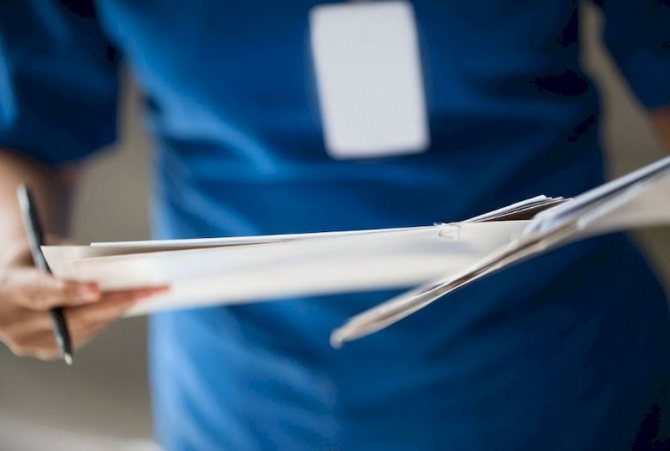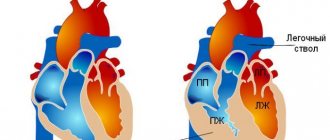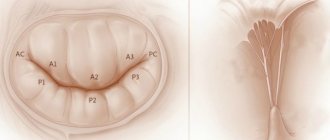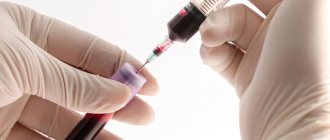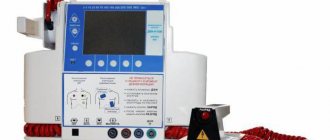Types of bleeding
To effectively help with bleeding, you need to have an idea of its nature. It is not difficult to determine the type of bleeding; there are 3 types:
Arterial bleeding
Arteries are vessels that carry blood from the heart to the periphery, to all organs and tissues. The blood enters them in impulses as a result of the contraction of the heart - systole, in addition, it has passed through the pulmonary circle and is enriched with oxygen. Accordingly, if the artery is damaged, it will have the following characteristics: it exits as a pulsating stream, in accordance with the rhythm of the heartbeat, and is bright scarlet in color.
Venous bleeding
Through the veins to the heart in the opposite direction, “waste” blood flows from organs and tissues, which has given up oxygen and is saturated with carbon dioxide. It occurs as a result of the attractive force of the heart during relaxation of the heart muscle (diastole). Therefore, if a vein is damaged, it will flow out in a uniform stream and have a dark color.
Capillary bleeding
Capillaries are multiple tiny ends of blood vessels located in the skin, through which tissue cells receive oxygen from arterial blood. Damage to capillaries occurs due to superficial injuries: abrasions, scalp wounds. Blood in such injuries has a bright scarlet color and is released gradually and evenly over the entire surface of the wound, as if seeping, without pulsation.
The first 2 types of bleeding can be stopped by applying a tourniquet, but with capillary bleeding it is contraindicated and makes no sense. It is enough to apply a pressure bandage and cold to the wound area.
State Description
Arterial bleeding is a rapid release of blood from a blood artery caused by its damage. Blood flows out of the wound in a pulsating stream in time with the work of the heart muscle.
When small arteries rupture, a person has only 30-60 minutes to stop the bleeding. If large arteries (carotid, femoral) are damaged, loss of consciousness and death can occur within a few minutes.
Arterial bleeding can be external (blood is released outside the body) or internal (blood is released into the abdominal cavity, lungs or muscles).
The consequences of blood loss largely depend on how effectively the compensation mechanisms work:
- Vascular reflex. It comes into effect on the first day after the injury. It consists in the release of adrenaline, which, acting on the vessels, leads to the inclusion of blood deposited in the veins into the general bloodstream.
- Hydremic. Characterized by replenishment of blood flow with intercellular fluid.
- Bone marrow. The production of red blood cells and other blood cells in the spinal cord is activated.
Arterial bleeding is especially dangerous for children and the elderly, since their protective compensation mechanisms work less well.
Distinctive signs of arterial bleeding
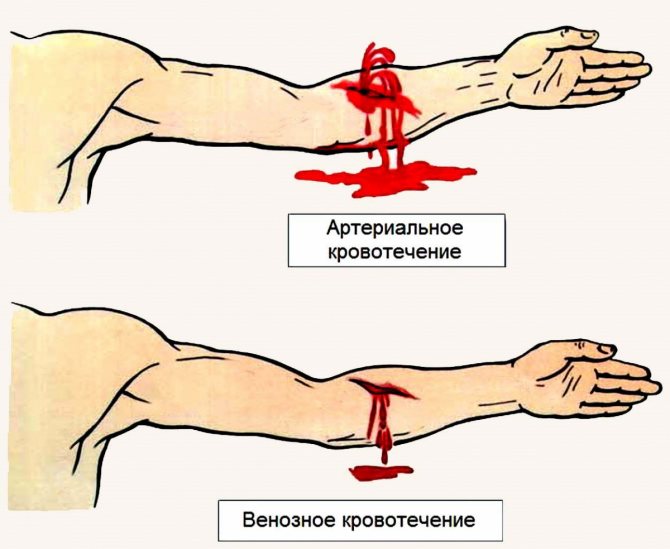
In order for first aid for arterial bleeding to be timely and as effective as possible, you should be able to distinguish it from venous bleeding.
Venous bleeding is characterized by the flow of blood in a slow stream that is dark in color. During arterial bleeding, blood flows out in a scarlet, pulsating stream.
It is quite simple to stop the flow of blood from a vein by applying a pressure bandage and ensuring the damaged area is in an elevated position. When an artery ruptures, it is very difficult to stop the bleeding. Effective ways to save a person in this case would be finger pressure (temporary measure), application of a tourniquet or tight tamponade.
Signs of bleeding
Bleeding, in addition to the described external signs, also has general symptoms associated with blood loss:
- pale skin;
- dizziness, ringing in the ears;
- decreased blood pressure;
- increased heart rate - tachycardia;
- cold clammy sweat;
- fainting state.
With severe blood loss, for example, from the carotid artery, symptoms increase quickly and hemorrhagic shock develops: severe lethargy, low blood pressure, weak pulse.
Loss of 2 liters of blood or more if assistance is not provided in a timely manner can be fatal.
When is a tourniquet necessary?
A tourniquet is applied to temporarily stop bleeding on those parts of the body where it can compress a bleeding vessel - on the limbs and neck. Indications for its application are arterial bleeding from wounds of the shoulder, forearm, hand, foot, leg, thigh.
The exception is the fingers and toes, where the artery can be pressed against the phalanx bone with a pressure bandage. For venous bleeding, a tourniquet is applied only in cases where the application of a tight pressure bandage has no effect.
If there is bleeding from the veins of the leg due to varicose veins or deep thrombophlebitis, the tourniquet will not have an effect due to the reverse discharge of blood in the diseased veins.
In addition, it can worsen the condition of the veins.
Tourniquet technique
The algorithm for dealing with bleeding is as follows:
- Determine the type of bleeding.
- Press over the wound with your hand.
- Apply a tourniquet, but “extra” hands will not hurt, especially if the bleeding is severe.
- Apply a sterile bandage to the wound.
- Write a note indicating the time of application of the tourniquet and attach it, slipping it under the tourniquet.
- Urgently transport the victim to the hospital, it is better to call an ambulance.
When applying a tourniquet, the type of bleeding should be taken into account: if arterial, apply above the wound, if venous, apply below, at a distance of 6-10 cm from the wound. It is also necessary to know the anatomical areas where arteries can be clamped:
- upper third of the thigh;
- upper and middle third of the shoulder;
- neck.
In these areas, the artery runs close to the bone and can be compressed. On the lower leg and forearm, the arteries go deep, in the interosseous space; applying a tourniquet does not make sense.
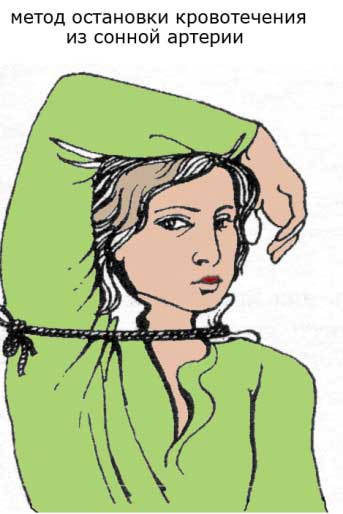
A tourniquet is applied to the neck if the carotid artery is damaged. This requires quick action because the blood loss is very large. The neck cannot be wrapped in a tourniquet like a limb, so a hard object is placed on the healthy side of the neck, most often this is the victim’s raised hand. The artery must be pressed to the spine below the site of injury, a bandage should be applied and a tourniquet on top, secured to the healthy side.
The skin under the tourniquet must be wrapped in cloth. In the absence of a tourniquet, you can use a belt, a thick cord, a rope, or a strip of thick fabric, tightening them with a twist on the undamaged side. In case of arterial bleeding, the twist is applied above the wound, in case of venous bleeding - below. It is also necessary to protect the tourniquet from stretching and relaxing by securing it well.
The maximum time for applying the tourniquet should be observed in summer and winter.
For arterial bleeding in cold weather, continuous compression with a tourniquet should not exceed 1.5 hours, in warm weather - 2 hours. It is necessary to loosen the tourniquet every 30-40 minutes, after pressing the bleeding vessel with your hand.
Venous tourniquets are applied for a maximum of 6 hours.
The technique for applying venous tourniquets is different; the compression force should be less, but sufficient to stop bleeding, while maintaining pulsation of the arteries below the wound.
General principles of first aid
If arterial bleeding occurs, first aid should be provided immediately.
The following actions should be taken:
- lift the injured part of the body;
- press the wound with your fingers slightly above the rupture site (a short-term measure, used to reduce blood loss before applying a tourniquet);
- apply a tourniquet, a pressure bandage, or pack the damaged area;
- call an ambulance or independently deliver the victim to a medical facility.
The method of stopping bleeding depends on its location. If the thigh, forearm and arm are injured, it is necessary to apply a tourniquet, after first pressing the artery to the bony protrusion above the damaged area. Pressing is done like this:
- in case of a thigh injury: it is necessary to press with your fist on the upper third of the thigh in the area of the inguinal ligament;
- if the forearm is injured: place several rolls of medical bandage in the elbow bend and squeeze the arm tightly in the joint;
- if an artery in the arm is ruptured: stick your fist into the armpit (you can use a bottle) and press your arm to your body.
Damage to the cervical arteries
There are two large arteries in the human neck: the carotid and the subclavian. Bleeding in this location is stopped by applying a tight wound tamponade.
Recent Entries
Is it possible to give a mirror: how to protect yourself from bad omens It became known about the influence of cell phone towers on human health Is it possible to eat bananas bought in Russia?
The procedure is carried out using tweezers: a sterile bandage or napkins are tightly placed into the wound cavity, after which the damaged area is tightly bandaged.
In the absence of tweezers and a sterile bandage, it is advisable to use a clean handkerchief, previously soaked in alcohol or other strong alcohol. Fingers should also be disinfected with alcohol or hydrogen peroxide.
Regardless of the location of the wound, the patient should be immediately taken to the hospital (or call an ambulance). The effectiveness of pre-medical measures to save a person will depend on the speed of providing professional medical care.
Errors when applying a tourniquet and their consequences

When applying a hemostatic tourniquet, the following errors are possible:
- Wrong choice of location - without taking into account the nature of the bleeding, this will only increase blood loss.
- Weak tightening of the tourniquet during arterial bleeding, which can be judged by the pulsation of the arteries below the wound (on the foot, wrist).
- Failure to comply with the tourniquet application time. This can lead to tissue necrosis, the development of atrophy, paralysis and even gangrene of the limb.
- Application of a tourniquet to exposed skin, which causes pinching to the point of necrosis.
- There is no note under the tourniquet indicating the time it was applied. It is very important to know when to release the tourniquet to avoid the development of tissue necrosis.
- Covering the tourniquet with clothing and a bandage. He must be “visible” in order to quickly direct him to provide further assistance to the patient.
Distinctive signs of arterial bleeding
The classification of bleeding implies its division into three main types:
With extensive traumatic injuries, mixed bleeding, for example, venous and arterial, can be observed. In addition, any bleeding, relative to where the blood flows, is divided into internal (in the body cavity) and external (into the external environment). First aid for internal bleeding, as well as its diagnosis itself, is carried out exclusively by medical staff. External bleeding is easier to diagnose and can be treated by anyone.
Arterial bleeding occurs due to damage to the arterial trunks - the vessels that carry oxygenated blood from the cavities of the heart to all tissues of the body. Venous-type bleeding develops when the integrity of the veins that collect blood saturated with carbon dioxide and carry it to the heart is disrupted. Capillary bleeding occurs due to traumatization of capillaries - small vessels that are directly involved in tissue gas exchange.
With arterial bleeding, the color of the flowing blood is bright red or scarlet, in contrast to venous bleeding, in which the blood is dark red and comes out slowly. In the case of arterial damage, blood is released rapidly, in a gushing stream. At the same time, the blood stream pulsates, each portion of it comes out synchronously with the pulse and heartbeat. This is due to high pressure in the arterial vessels that come directly from the heart.
In case of arterial bleeding, if help is not provided in time, the phenomena of hemorrhagic shock quickly increase - a pathological condition due to significant blood loss. It has the following symptoms:
- drop in blood pressure;
- increased heart rate;
- pallor and marbling of the skin;
- cyanosis of the extremities;
- respiratory disorders;
- decreased diuresis;
- severe weakness;
- dizziness;
- cold extremities;
- loss of consciousness.
Causes of arterial bleeding
There are many factors that can provoke the opening of arterial bleeding. Among them are:
- gunshot and knife wounds of the upper extremities, neck, abdominal cavity, chest;
- rupture of arterial walls against the background of acquired or congenital pathologies, the development of which leads to weakening of the arteries, disruption of their integrity as a result of increased static pressure);
- accidents at home or at work when a person works with cutting, grinding tools or with equipment that is a source of increased danger (during the work there is a risk of injury to soft tissues with subsequent rupture of arteries);
- open fractures (when such an injury occurs, the bone is displaced, which leads to a violation of the integrity of the membranes of nearby arteries);
- falling from a great height;
- diseases of the circulatory system, in the development of which there is an acute deficiency of platelets;
- postoperative complications (in this case, bleeding is a consequence of medical error or poor-quality intervention).
Sometimes the opening of bleeding is provoked by purulent tissue lesions when arteries are involved in the pathological process. Also, the cause of this condition may be hidden in poor blood clotting and liver pathologies. Among them, the greatest danger is:
- von Willebrand disease;
- hepatitis;
- cirrhosis;
- hypovitaminosis K;
- fibrinogen deficiency;
- hemophilia.
In addition, provocateurs of damage to the protective membranes of the arteries may be:
- diabetes;
- infections (sepsis, viruses);
- poisoning
Establishing the cause of arterial bleeding is an important point, as this makes it possible to quickly eliminate blood loss and prevent its occurrence in the future, especially if this condition occurs against the background of chronic diseases of the vascular system.
First aid
The most important role in emergency care for bleeding of arterial origin is played by the time factor: for maximum effectiveness it should be provided no later than 2-3 minutes from the moment of injury. If it concerns the main arterial trunks, then bleeding from them must be stopped no later than 1-2 minutes after the injury. Otherwise, the chances of a successful outcome will decrease every second with every milliliter of blood lost.
The algorithm for stopping any arterial bleeding is as follows:
- Assessing the type of bleeding.
- Finger pressure on an artery that is damaged.
- Applying a tourniquet, applying maximum limb flexion or a pressure bandage.
- Applying an aseptic dressing to the wound.
This sequence of actions may vary slightly depending on the characteristics of the damaged anatomical area.
Methods to stop bleeding can be temporary or permanent. Temporary arrest of arterial bleeding is used at the stage of first premedical and medical care. The final stage is carried out in a hospital and is part of the hospital stage of care. It is worth noting that in some cases, temporary stopping measures are enough to completely stop the bleeding.
First aid for venous bleeding
Help for the victim in this case depends entirely on the nature of the injury. If the superficial veins are damaged, you must first press down the damaged vessel and wash the wound with hydrogen peroxide or bandage the affected area by inserting a tampon with an antiseptic. Stitching the wound will help to finally stop severe bleeding.
If deep veins are damaged, it is necessary to tightly push tampons with hydrogen peroxide into the wounds. After this procedure, you need to apply a pressure circular bandage, and quite tight. All further actions must be carried out by a doctor, and the sooner he begins treating the wound, the better for the patient.
If damage to the vessels of the neck is observed, you need to press the ends of the bleeding vein through the skin with your fingers, and clamp the vessel in the wound itself. After this, you need to place tampons with hydrogen peroxide. After providing first aid, the doctor must apply stitches.
When providing first aid for various bleeding, you need to remain calm and strictly follow the sequence of actions.
Arterial bleeding is characterized by a massive splash, a fountain of blood from the injured area. This condition is quite dangerous, since if first aid was not provided in a timely manner, the person may die from blood loss.
Finger pressure
This technique should be used as a starting one when assisting a wounded person. The basic principles of digital compression depend on the anatomical region in which the artery injury occurred. The general rule is that the vessel should be pressed above the site of injury. But if bleeding occurs in the neck or head area, then the vessels are compressed downward from the wound. This is explained by the fact that the arteries in this area go upward from the heart.
Attention! When using any methods to stop bleeding, you need to lift the affected limb upward to reduce blood flow to it.
Damaged arterial vessels must be pressed against the bony protrusions, as they can slip out, and then bleeding will resume.
To better remember the method, you can use the 3D mnemonic rule:
It means that you need to press the artery by pressing with ten fingers of both hands for 10 minutes, after which it is recommended to check whether the bleeding has stopped. If it is stopped, and this happens if it is not the main arterial vessel that is damaged, then you can limit yourself to applying a pressure aseptic dressing to the wound.
Since the blood pressure in the arteries is very high, it will take a lot of effort to apply pressure to the vessel and stop the bleeding. Finger pressure is a method of temporarily stopping bleeding, so while one person is pressing the artery, the second should already be looking for a tourniquet and dressing material. There should be no time wasted taking off clothes or freeing limbs. At the same time, one of the eyewitnesses must immediately call an ambulance to provide first aid and transport the victim to a hospital.
The biggest disadvantages of the finger pressing technique are:
- significant pain for the injured person;
- physical fatigue of the person providing emergency assistance.
Speed of execution is considered the most important advantage of temporarily stopping external arterial bleeding using finger pressure.
Maximum fixed limb flexion
In some cases, you can use maximum flexion of the limbs as a method of temporarily stopping bleeding from the artery. It should be performed after making sure that the victim does not have a fracture of the injured limb.
After inserting the roller, the bent arm or leg is fixed to the patient’s body. Such actions are aimed at temporarily stopping bleeding, and if they are ineffective, one should prepare to apply an arterial tourniquet. This same technique, even when performed correctly, has questionable effectiveness.
Applying a tourniquet for arterial bleeding
Stopping bleeding from an artery by applying a tourniquet is a temporary method of stopping bleeding. The task of everyone who helps the victim is to correctly perform the technique of applying a tourniquet and ensure the delivery of the wounded person to a medical facility.
A tourniquet should be applied only in case of severe arterial bleeding. In all other cases, you should try to stop the bleeding with digital compression or a pressure bandage. A pressure bandage is made in case of arterial bleeding from a whole roll of sterile bandage, which is tightly fixed to the wound surface.
This is especially true for the shoulder region, because the radial nerve is located superficially there. A tourniquet is applied to the middle third of the shoulder only as a last resort. It is better to choose a place higher or lower. One of the available means can be used as a tourniquet: a wide rope, a belt or a scarf.
So how to apply a tourniquet during arterial bleeding so as not to harm the patient in the future? By remembering a few basic rules, you can avoid a lot of mistakes.
The algorithm for applying a tourniquet is as follows:
- Select a place to apply the tourniquet. It is located above the site of damage, but as close as possible to it (the optimal distance is 2-3 cm). We should not forget about injuries to the neck and head - there a tourniquet is used below the wound. If the femoral artery is damaged, it is compressed at the level of the middle third of the thigh, and if there is bleeding from the arm, it is compressed in the upper or lower third of the shoulder.
- Wrap the selected area with cloth, gauze or bandage.
- The limb should be in an elevated position.
- The tourniquet is stretched and made several turns around the limb. In this case, its first turn is made with greater, and all subsequent turns with less effort. If large arterial trunks are damaged, for example, the femoral artery, it makes sense to apply two tourniquets - one higher, the other lower.
- Its ends are tied into a knot or secured with a special chain or hook.
- The correct application of the tourniquet is checked: pulsation of the injured artery below the injury is not palpable, and bleeding from the wound stops.
- The exact time of application of the tourniquet is recorded. This can be done on a piece of paper, which is inserted under the tourniquet itself, directly on the patient’s body near the site of injury, or on clothing.
- An aseptic bandage is applied to the wound.
In case of injuries to the carotid artery, the tourniquet is applied below the injury, but it should not compress the artery of the same name on the other side. To do this, a tight roller is applied on the side of the injury, and a tourniquet is fixed on the opposite side through the patient’s raised arm and an attached flat board.
The tourniquet should not be applied too tightly, since applying the tourniquet correctly means applying minimal pressure to stop the bleeding. In this case, the blood supply should be carried out through deep arteries and veins, and in no case should it stop completely.
The time factor is also important here. The maximum time for applying a tourniquet varies depending on the ambient temperature:
- in summer - for 1 hour;
- in winter - for 30 minutes.
If a longer time interval is required to transport the victim to the nearest hospital, the tourniquet is temporarily removed, switching to 10 minutes of finger pressure. Then you need to apply a tourniquet again according to the rules described above.
Twist tourniquet
In the absence of a special tourniquet, you can use an improvised twist tourniquet. To form it, you need to take a wide ribbon, scarf or piece of fabric and wrap it around the limb above the wound site. The fabric is then tied using a double knot. A small stick is inserted into the gap between the resulting nodes and twisted with rotational movements until the bleeding stops.
The stick is fixed with a rope above the place where the tourniquet is applied to the limb, also with double knots. A note is placed under the tourniquet indicating the exact time of application of the twist.
Thus, due to the direct threat to life that occurs with arterial bleeding, you need to act very quickly. The briefly described first aid rules will help you not to panic and, in an extreme situation, save someone’s life.
Ways to stop arterial bleeding
All methods of stopping bleeding can be divided into two groups: temporary and final. Temporary stoppage of bleeding is carried out at the pre-medical stage of medical care. The final stop is carried out in the hospital. This division applies mainly to severe bleeding, since weak bleeding can be completely stopped at the pre-medical stage.
Before providing first aid, remember to protect yourself! If possible, wear gloves (included in your car first aid kit) or try to have as little contact with the victim’s blood as possible.
Reasons for donating blood for HIV: https://krasnayakrov.ru/analizy-krovi/analiz-krovi-na-vich.html
Finger pressure
It is carried out according to the 3D rule: press ten to ten . This means pressing the artery with both hands (10 fingers) against the bone for 10 minutes. This time will be enough to stop minor bleeding. However, with heavy blood loss, finger pressure is not a reliable measure.
Application of a tourniquet
This method is most effective for extensive arterial bleeding. The car first aid kit contains a special tourniquet to stop bleeding. But it can also be made from improvised materials - it could be a belt, a scarf, a tie.
Remember - the wider the tourniquet, the better. Do not use thin ropes or wires, this may lead to tissue necrosis!
The tourniquet should not be applied directly to the skin; secure it over clothing or first bandage the injury site with a cloth. It is necessary to check the pulsation of the artery below the application site. If the pulsation on the side of the tourniquet is weak or not detected at all, then the tourniquet is applied correctly and effectively.
In case of severe blood loss, a blood transfusion is indicated for the victim: https://krasnayakrov.ru/donorstvo/pokazaniya-i-protivopakazaniya-pri-perelivanii.html
An important point is the time of application of the tourniquet. In summer, the tourniquet can be applied for 1 hour, in winter - for 30 minutes. During this time, the underlying tissues will be able to be supplied with blood from deep-lying arteries and venous blood remaining after applying the tourniquet, without undergoing necrosis.
As soon as the tourniquet is applied, take a piece of paper and write the exact time on it. Remember that in extreme conditions, the sheet may get lost, rubbed, dirty, and the information will become inaccessible. To be completely sure, you can write the time directly on the victim’s body, his clothes or other available means. After the specified period, the tourniquet should be removed for 10 minutes so that the tissues are saturated with oxygen, then the tourniquet is applied according to the same scheme.
There are certain features in applying a tourniquet to the area of the carotid artery - the tourniquet should not impede blood flow from the opposite side. To do this, a cotton-gauze roll is applied to the site of damage over the clothing, after which a tourniquet is applied, which, on the other hand, is pulled over the victim’s raised hand and thrown behind the head, or through a splint (this can be a found piece of wood or any other rigid stick).
Fixed limb flexion
Currently, this method of stopping bleeding is ineffective, since in living conditions a person’s limbs are already in a bent state, and no disturbances in blood flow occur.
It is also considered a mistake to apply cold or ice, since the rate of blood clotting increases at high temperatures, so it is more advisable to use warming compresses.
An important indicator of blood clotting: https://krasnayakrov.ru/analizy-krovi/agregatsiya-trombotsitov-vazhnyiy-pokazatel-svyortyivaemosti.html
Application of a tourniquet
Everyone should know how to apply a tourniquet for arterial bleeding. You never know when the knowledge you gain will come in handy. Arterial bleeding is dangerous for the patient’s life; if help is not provided in a timely manner, he will die. This is the most dangerous injury. Blood flows from the wound like a fountain, it is impossible to confuse it with another type of bleeding.
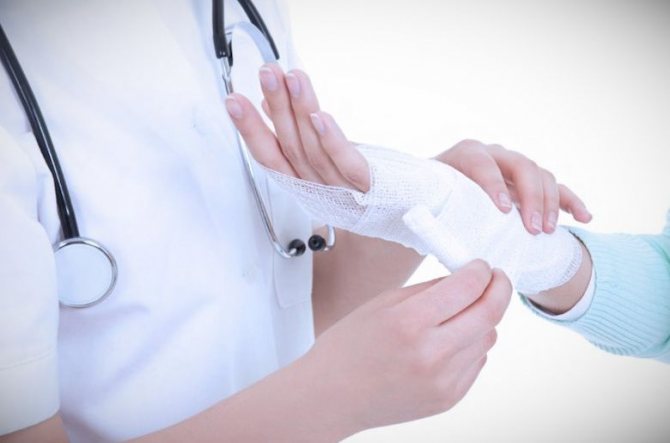
Ways to stop arterial bleeding
The integrity of the artery can be completely restored only in stationary conditions by suturing the vessel. Until the patient is hospitalized, methods of temporarily stopping arterial bleeding are actively used. Depending on the situation and conditions, various techniques can be used to save the victim’s life.
Among the effective techniques:
- Pressure of a large artery.
This kind of first aid for injuries that occur can completely stop blood loss. It is used for small lesions, when it is possible to quickly hospitalize. - Application of a tourniquet.
A tight rubber bandage helps to completely stop blood circulation in the artery, resulting in stopping bleeding. In case of arterial bleeding, a tourniquet is applied above the wound site. - Pressure bandage.
A temporary method of stopping bleeding, effective for minor arterial injuries, used in the prehospital stage.
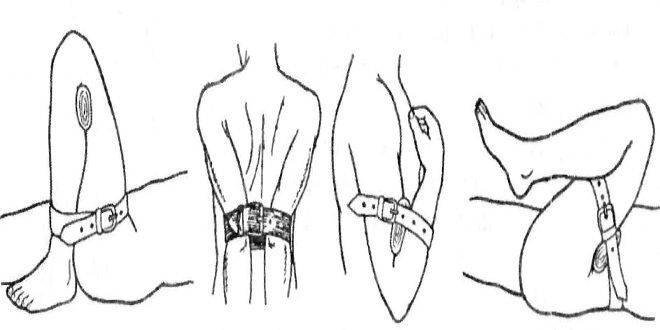
Rules for applying a tourniquet for arterial bleeding
Even with proper medical care, the patient may die or lose a limb. The blood loss is so great that assistance is provided in the first 2-3 minutes after the injury. Rules for squeezing and pressing a damaged artery:
- The carotid artery is pressed to the spine - to the transverse processes of the cervical vertebrae.
- The external maxillary artery is pressed against the anterior edge of the masseter muscle.
- The temporal lobe is compressed forward from the upper edge of the ear.
- The subclavian is pressed with your fingers to the first rib.
- The brachial artery is compressed along the inner edge of the biceps muscle towards the bone.
- The femoral artery is pressed against the pubic bone with a fist. In thin victims, pressure can be applied to the thigh.
- The popliteal cavity is also pressed with a fist in the middle of the popliteal cavity.
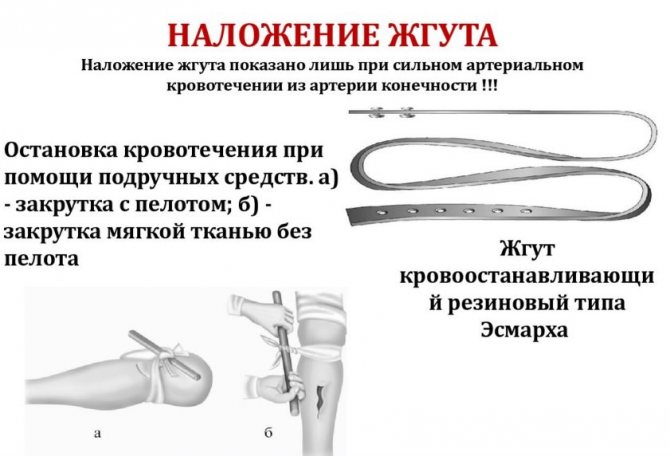
Finger pressure of the arteries is the first stage of providing assistance to the victim. Next comes the technique of applying an arterial tourniquet. The patient’s life depends on how quickly and correctly the tourniquet is applied. If there is no medical accessory at hand, then use a belt, scarf, or rope.
Actions before the arrival of doctors
If the medium arteries are injured, the first two to three minutes may be critical, one or two minutes if the large ones are affected. Therefore, we must act clearly and quickly. The first thing to do is to pinch the arteries with your fingers. In case of arterial bleeding, the following should be considered:
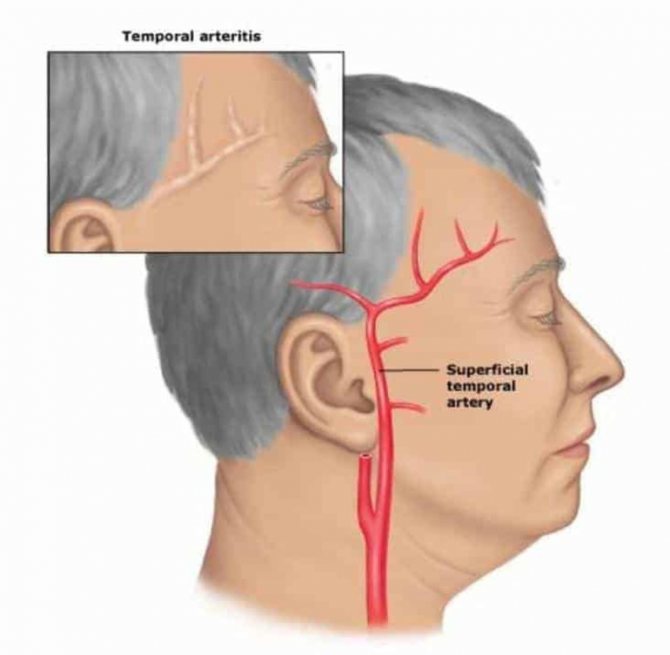
- The temporal artery is compressed in front of the upper area of the auricle.
- The left or right subclavian artery is pressed against the outer edge of the clavicle (the area of the sternocleidomastoid muscle).
- The outer jaw is pressed against the masticatory muscle.
- If the brachial artery is damaged, it is compressed in the area of the biceps muscle, pressing it against the bone located in this area.
- The popliteal artery is pressed in the middle of the knee cavity.
- If the femoral artery is injured, it is pressed against the bone in the pubic area. If the patient is thin, you can apply pressure to the thigh.
Timely assistance increases the victim's chances of survival. This will reduce blood loss. It may be useful to check the victim’s heart function.
Although most are accustomed to taking the pulse on the arm, in an injured person it may be very weak in this area. Then it is better to measure the heart rate using the carotid artery. It is located in the neck area. How to do it correctly:
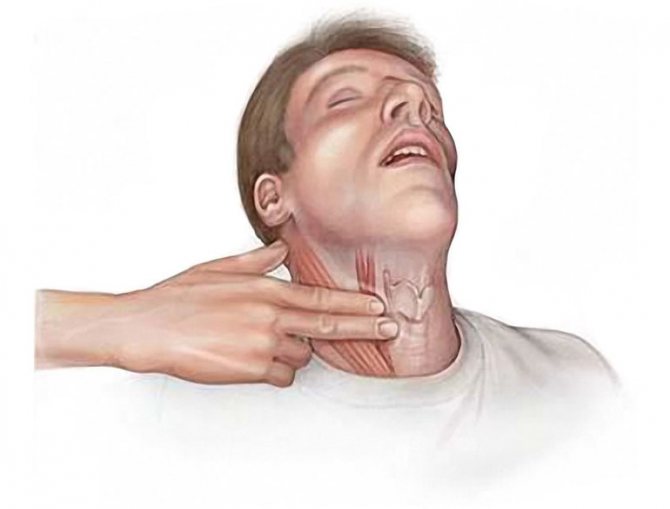
- It is better to measure with your right hand on the right. On the left side, you can clamp two arteries at once, then the result will be inaccurate.
- Place the patient on a chair and let him lean on his back. If a person cannot sit, he must be laid down with his head slightly raised.
- Place your index and middle fingers on the area between the chin and earlobe (2 cm below).
- Don't push too hard! If the carotid artery is pinched, a person can lose consciousness and even die.
Once you feel your pulse beating, you need to note the time using the second hand. The norm would be between 60 and 80 beats per minute.
Algorithm for applying an arterial tourniquet:
- A cloth is placed over the wound, but it does not reach the bleeding site.
- If the limbs are damaged, they are in an elevated state.
- The location of the tourniquet for arterial bleeding depends on the location of the injury, but always 2 cm above the wound from which blood is gushing.
- If the arms are damaged, it is used on the upper third of the shoulder. Applying a tourniquet to the shoulder during arterial bleeding is possible only in its upper or lower third, otherwise there is a risk of damage to the radial nerve. If the injury touched the axillary artery, then the technique is the same.
- Applying a tourniquet for femoral artery bleeding may require additional measures. If the bleeding does not stop, then you need to apply an additional tourniquet, higher than the previous one.
- The correct procedure for applying a tourniquet to the carotid artery comes down to applying a soft bandage under the elastic band itself to prevent additional injuries. They don't tighten tight. This will help avoid suffocation and oxygen starvation of the brain.
Other methods
In case of arterial bleeding, it is necessary not only to do everything possible for the wounded, but also to protect against diseases. Before you begin to provide assistance, you should put on medical (or simply rubber) gloves. If they are not there, wrap several layers of gauze and bandage around your palms. Plastic bags and products made from any waterproof material will do. In the case when there is nothing of the kind, the wound should be pressed with the hand of the victim himself. Further actions:
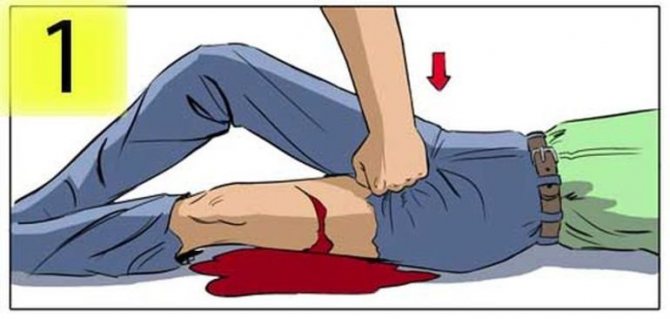
- Remove or tear clothing to get to the wound where the blood is coming from.
- Take a sterile napkin, a clean cloth. Cover the surface of the wound completely with it and press firmly with your hand from above. Hold for at least five minutes. Most bleeding can be stopped this way. In this case, the lumen of the damaged vessels is compressed, and the natural processes of blood clotting begin to work, thanks to which the bleeding stops. A blood-soaked bandage should not be removed. Place a clean one on top.
- If blood is flowing from a limb, the affected area should be elevated so that it is above the level of the heart. This will reduce the pressure and force of blood flow.
- After pressing, a bandage should be applied so that attention can be given to other victims, if any.
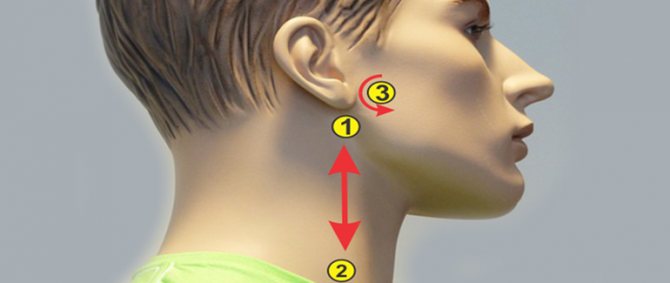
It would be good if there was a person with a medical background at the scene of the incident. He will be able not only to name the signs of arterial bleeding, but also to identify those places where the arteries are located close to the skin. By pressing on them, you can quickly stop even a strong outflow.
If a person has lost a large amount of blood, one should try to avoid the onset of hypovolemic shock (a sharp decrease in blood flow). The victim needs clean air. It is better to remove excess clothing, lay the person on his back, raise his legs to an elevated position - then the blood will concentrate around the vital organs. If the injured person is conscious, you need to give him water; tea with sugar will do. Try to calm the victim and make sure that he does not move unnecessarily. If the patient has lost consciousness and is not breathing, cardiac massage (indirect) will be needed.
Danger of bleeding
The first three minutes after injury are important. Help is needed during this period. Since during arterial bleeding everything happens quickly, the body does not have time to turn on protective mechanisms and reserves. Blood is quickly lost and circulation may stop altogether, leading to death. It is possible to completely stop the bleeding in a medical facility. Doctors bandage or stitch the vessel in the wound. If internal bleeding occurs, the victim needs urgent surgery.
After taking measures to eliminate bleeding, it is important to provide the victim with qualified medical assistance in a timely manner, otherwise 10 hours after assistance is provided, a critical moment comes. The patient develops gangrene and can only be saved by amputation of the damaged limb.
If there is significant blood loss, the patient is given a transfusion from a donor. The volume is up to 1000 cubic centimeters, but a pulsating hematoma can be a complication. It requires immediate surgical intervention.
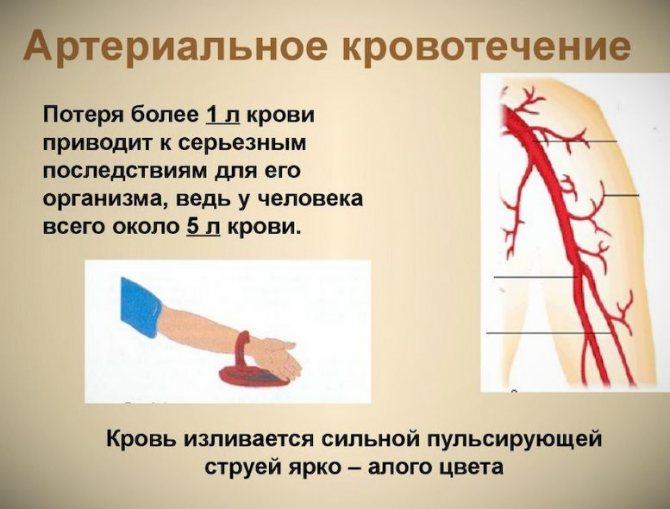
Signs of improper tourniquet application
There are a number of common mistakes when providing medical care for arterial bleeding. These include:
- The procedure was carried out without indications.
- The rubber is loose. This will cause the blood flow to not stop.
- The rubber is too tight. There may be damage to muscles, fibers, and nerves.
- Lack of a note with information about how the injury occurred and when first aid was administered.
- Concealing an injury with clothing or bandages. Doctors must see the injury immediately. That is, the tourniquet should be conspicuous. The time wasted can cost the patient his life.
- Incorrect harness location. It cannot be installed on a naked body, or far from work.
- Installation in the middle third of the shoulder.
- Do not allow the damaged area to freeze in winter.
- During transportation, the limb must be immobilized.
First aid is the most important knowledge not only for doctors, but also for ordinary people. No one ever knows when and what knowledge will suddenly be needed. Bleeding can be not only arterial, but also venous. You should read about how to stop venous bleeding here.
In medical institutions, for arterial injuries, an Esmarch hemostatic tourniquet is used. But now is the 21st century, so such a device can be purchased at any pharmacy. Such a thing in your home medicine cabinet may not be useful, but if you suddenly need it, it can save your life. Its price is not so high as to raise doubts about the need for such a thing in a home medicine cabinet. It is also important to study information on first aid, and it is better to take additional courses that will help you apply knowledge in practice. You should read about how venous tourniquets are applied for pulmonary edema here.
